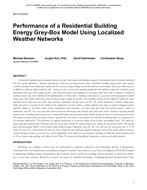
DA-13-C015 — Performance of a Residential Building Energy Grey-Box Model Using Localized Weather Networks
- Comments Off on DA-13-C015 — Performance of a Residential Building Energy Grey-Box Model Using Localized Weather Networks
- ASHRAE
Customized building energy consumption forecasts can give home owners and building managers the information needed to operate residential HVAC systems efficiently in dynamic environments. However, generating forecasts from conventional building energy models often requires extensive investment and computational effort, and the necessary energy auditing, construction material measurements, and system monitoring can be difficult to justify for single residential units. Accuracy is also a concern when involving complexities like multiple temperature set points, system degradation with time, and changing weather. This work investigates the performance of an energy model that could be applied to millions of residential homes due to the simplicity of its implementation. In this model, a building is represented as a grey-box system balancing the sensible energy of the entire indoor environment with the flow of energy through the envelope. This modeling accounts for heat diffusion through the walls, convection on the inner and outer walls, solar irradiance, infiltration, thermal mass, and HVAC system performance. Transient temperatures within the wall are accounted for by solving for the temperatures at nodes within a uniform property wall using an explicit tridiagonal matrix algorithm. Inputs to the model include outdoor temperature, solar insolation, and wind speed data from local weather stations, indoor air temperature, and HVAC status data from internet connected thermostats, and electricity data from smart meters. Instead of requiring detailed measurements of building characteristics such as insulation R-values and fenestration ratios, effective parameter values are calculated from the data. The solution technique consists of using a Genetic Algorithm (GA) to obtain a least squares curve that fits the modeled indoor air temperatures to the measured temperatures. The parameters are updated periodically to account for changes in the weather and building status. The model was tested using data obtained from 154homes across five of the eight ASHRAE defined climate zones during the late spring of 2012. The average daily root-mean-square (RMS) errors between model predicted indoor temperature and HVAC ON time and the actual data were 0.79 °F (0.44 °C) and 3.2%, respectively for the entire set. It was shown that no statistically significant difference existed in the models ability to predict a certain subcategory of house verses the mean. Several applications of the model are also introduced, including an 800 home demand response trial in Texas, remote energy auditing, and software to test “what if” scenarios involving different temperature set points and retrofit upgrades.
Citation: ASHRAE Conference Papers, Dallas, TX.
Product Details
- Published:
- 2013
- Number of Pages:
- 8
- File Size:
- 1 file , 1.8 MB
- Product Code(s):
- D-DA-13-C015

